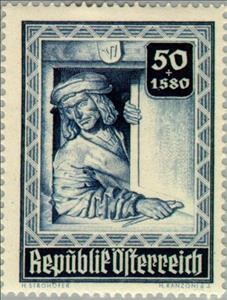Stamp: Master Anton Pilgram (16th Cty.) self portrait (Austria 1946)
Master Anton Pilgram (16th Cty.) self portrait (Austria 1946)
12 December (Austria ) within release Rebuilding Stephan's Cathedral, Vienna goes into circulation Stamp Master Anton Pilgram (16th Cty.) self portrait face value 50+180 Austrian groschen
| Stamp Master Anton Pilgram (16th Cty.) self portrait in catalogues | |
|---|---|
| Michel: | Mi:AT 798 |
| Yvert et Tellier: | Yt:AT 660 |
Stamp is vertical format.
Also in the issue Rebuilding Stephan's Cathedral, Vienna:
- Stamp - Duke Rudolf IV (1339-65) founder of the cathedral face value 3+12;
- Stamp - Tomb of Emperor Friedrich III (1415-93) face value 5+20;
- Stamp - Pulpit of Anton Pilgram (16th Cty.) face value 6+24;
- Stamp - St. Stephan (giant gate), 15th Cty. face value 8+32;
- Stamp - Servant's Madonna, Barbara Chapel in the cathedral face value 10+40;
- Stamp - Baroque high altar before destruction in 1945 face value 12+48;
- Stamp - Baroque organ in the West Gallery (destroyed 1945) face value 30+120;
- Stamp - Master Anton Pilgram (16th Cty.) self portrait face value 50+180;
- Stamp - North Tower of the cathedral face value 1+5;
- Stamp - South Tower of the cathedral face value 2+10;
Stamp Master Anton Pilgram (16th Cty.) self portrait it reflects the thematic directions:
Painting is the practice of applying paint, pigment, color or other medium to a solid surface (support base). The medium is commonly applied to the base with a brush, but other implements, such as knives, sponges, and airbrushes, can be used. Painting is a mode of creative expression, and the forms are numerous. Drawing, gesture (as in gestural painting), composition, narration (as in narrative art), or abstraction (as in abstract art), among other aesthetic modes, may serve to manifest the expressive and conceptual intention of the practitioner. Paintings can be naturalistic and representational (as in a still life or landscape painting), photographic, abstract, narrative, symbolistic (as in Symbolist art), emotive (as in Expressionism), or political in nature (as in Artivism). A portion of the history of painting in both Eastern and Western art is dominated by spiritual motifs and ideas. Examples of this kind of painting range from artwork depicting mythological figures on pottery, to Biblical scenes rendered on the interior walls and ceiling of the Sistine Chapel, to scenes from the life of Buddha or other images of Eastern religious origin. In art, the term painting describes both the act and the result of the action. The support for paintings includes such surfaces as walls, paper, canvas, wood, glass, lacquer, clay, leaf, copper and concrete, and the painting may incorporate multiple other materials including sand, clay, paper, plaster, gold leaf, as well as objects. The term painting is also used outside of art as a common trade among craftsmen and builders.
An architect is a person who plans, designs, and oversees the construction of buildings. To practice architecture means to provide services in connection with the design of buildings and the space within the site surrounding the buildings that have human occupancy or use as their principal purpose. Etymologically, the term architect derives from the Latin architectus, which derives from the Greek (arkhi-, chief + tekton, builder), i.e., chief builder
Painting is a visual art, which is characterized by the practice of applying paint, pigment, color or other medium to a solid surface The medium is commonly applied to the base with a brush, but other implements, such as knives, sponges, and airbrushes, may be used. One who produces paintings is called a painter.
A church building, often simply called a church, is a building used for Christian religious activities, particularly worship services. The term in its architectural sense is most often used by Christians to refer to their religious buildings, but it is sometimes used (by analogy) for buildings of other religions. In traditional Christian architecture, the church is often arranged in the shape of a Christian cross. When viewed from plan view the longest part of a cross is represented by the aisle and the junction of the cross is located at the altar area. Towers or domes are often added with the intention of directing the eye of the viewer towards the heavens and inspiring church visitors. Modern church buildings have a variety of architectural styles and layouts; many buildings that were designed for other purposes have now been converted for church use; and, similarly, many original church buildings have been put to other uses. The earliest identified Christian church was a house church founded between 233 and 256. During the 11th through 14th centuries, a wave of building of cathedrals and smaller parish churches occurred across Western Europe. A cathedral is a church, usually Roman Catholic, Anglican, Oriental Orthodox or Eastern Orthodox, housing the seat of a bishop.




